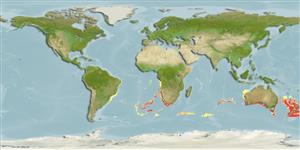Teleostei (teleosts) >
Anguilliformes (Eels and morays) >
Synaphobranchidae (Cutthroat eels) > Synaphobranchinae
Etymology: Diastobranchus: Greek, diastasis = separation + Greek, brangchia = gills (Ref. 45335).
More on author: Barnard.
Environment: milieu / climate zone / depth range / distribution range
Ecology
Marine; bathydemersal; depth range 183 - 2000 m (Ref. 57911). Deep-water; 3°C - 4°C (Ref. 96237); 5°N - 50°S, 50°W - 179°E
Circum-austral, except eastern Pacific (Ref. 26895). Distributed on the continental slope of South Africa, off Tasmania, New Zealand, Discovery Seamount and the Rio Grande Rise off South America (Ref. 5167). Also found in Argentina (Ref. 47881). First record from the far north (Spitzbergen, Svalbard Arch.) (Ref. 96237).
Size / Weight / Age
Maturity: Lm ? range ? - ? cm
Max length : 180 cm TL male/unsexed; (Ref. 57911)
Dark purplish black in color (Ref. 3973). Lateral line pores before anus about 27 (Ref. 3973).
Life cycle and mating behavior
Maturity | Reproduction | Spawning | Eggs | Fecundity | Larvae
Gon, O., 1990. Synaphobranchidae. p. 102-104. In O. Gon and P.C. Heemstra (eds.) Fishes of the Southern Ocean. J.L.B. Smith Institute of Ichthyology, Grahamstown, South Africa. (Ref. 5167)
IUCN Red List Status (Ref. 130435: Version 2024-2)
Threat to humans
Harmless
Human uses
Fisheries: of no interest
Tools
Special reports
Download XML
Internet sources
Estimates based on models
Preferred temperature (Ref.
123201): 4.2 - 9.6, mean 7 °C (based on 235 cells).
Phylogenetic diversity index (Ref.
82804): PD
50 = 1.0000 [Uniqueness, from 0.5 = low to 2.0 = high].
Bayesian length-weight: a=0.00051 (0.00026 - 0.00101), b=3.13 (2.95 - 3.31), in cm total length, based on LWR estimates for this species & (Sub)family-body (Ref.
93245).
Trophic level (Ref.
69278): 4.5 ±0.55 se; based on food items.
Resilience (Ref.
120179): Low, minimum population doubling time 4.5 - 14 years (Assuming tmax>10).
Fishing Vulnerability (Ref.
59153): Very high vulnerability (90 of 100).
Climate Vulnerability (Ref.
125649): High to very high vulnerability (66 of 100).
Nutrients (Ref.
124155): Calcium = 12.2 [7.4, 26.3] mg/100g; Iron = 0.37 [0.19, 0.73] mg/100g; Protein = 17.7 [15.5, 20.1] %; Omega3 = 0.324 [0.136, 0.888] g/100g; Selenium = 35.5 [15.9, 78.8] μg/100g; VitaminA = 7.52 [1.53, 39.41] μg/100g; Zinc = 0.226 [0.150, 0.341] mg/100g (wet weight);
